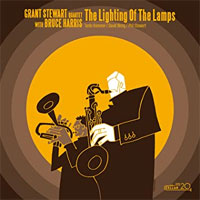Grant Stewart Quartet with Bruce Harris • The Lighting of the Lamps
Tenor saxophonist Stewart came up in Toronto before hitting New York, has been recording since the early ’90s, and deserves a wider reputation. His tone is warm, full and expressive, which is to say full of melodic and harmonic detail, and he revs it all up, a jackrabbit when he wants to be. Stewart loves go-for-broke Sonny Rollins but knows better than to imitate Sonny’s timbral eccentricities (or penchant for quotation). Stewart demonstrates familiarity with the masters without sounding beholden to any one of them. One might say the same about his front-line guest, generation-younger NY trumpeter Bruce Harris, tart-toned and feisty by inclination: he makes old licks sound like spontaneous observations. Stretching out on “I’m a Fool to Want You,” Stewart puts his sound on display, not least when he plumbs the melody’s low notes, or goes into the lovely bridge. You can almost feel the saxophone’s metal shell vibrate. He is similarly attentive on the other, not-overexposed standard, “Ghost of a Chance.” But those ballads are change-ups: this date is about harder stuff. Stewart and Harris pick some snappy, overlooked (if not forgotten) hard-bop numbers that make the program pop, in particular Clifford Jordan’s chipper waltz “Little Spain” (recorded with Lee Morgan in ’62), pianist Elmo Hope’s bright bounce “Mo Is On” (originally for trio, even brighter with horns), and Thad Jones’s spinning-top of a tune “Bitty Ditty.” Those tunes’ melodic features -- the chain of catchy/whistlable answering phrases of “Little Spain," the opening ascent of “Mo Is On” -- give Stewart motifs to dig into in a solo, orienting the listener. Harris’s hot-dogging is a little more blithe, less tethered to a tune. The contrast is effective, and they sound even better blended: two horns beautifully fused, on “Little Spain” in particular, speaking in one voice. Two horns put Clifford Jordan’s “Bearcat” (originally for quartet) in a flattering light. The hard-bop oldies also include Benny Golson’s 1957 “Out of the Past,” recalling his then-recent jazz hit “Whisper Not.” Stewart hews closest to the original here, and to a buoyant medium gait. It’s instructive to compare Wynton Kelly’s rolling piano solo from the original recording on Benny Golson's New York Scene with Tardo Hammer’s on Stewart’s take: the melodic/harmonic/rhythmic language is remarkably similar, but there’s no dust on the new one; it shows how attuned the players are to the idiom as a living style. Bassist David Wong is as self-effacingly in the pocket as a ’50s bassist. Drummer Phil Stewart (the leader’s brother) solos on “Bearcat” within the rhythm trio, ever the team player. He constantly comments on the action and frames the forms while calling little attention to himself; no self-congratulatory Blakey press rolls. The quartet-plus-one was recorded at the late Rudy Van Gelder’s New Jersey studio
by keeper of the flame Maureen Sickler. It’s fair to say recording at Van
Gelder’s gives players a psychological boost -- all that heritage. (The notes refer
to the date’s “sanctified” and “chapel-like” setting.) In
Rudy’s later years, the bass sound coming out of the Englewood Cliffs temple was not
always up to snuff. (Not to be unkind, but try the comedy classic Ron Carter Plays
Bach.) Sickler gets a more natural sound from plucked strings, and the balance is,
well, balanced. You can honor the past without repeating mentors’ mistakes. |

 azz substyles: there are a lot to keep
straight. Consider all the bops. First came the fast, frenetic, revolutionary 1940s bebop
of Charlie Parker and Dizzy Gillespie. The ’50s brought hard bop, more overtly
bluesy, with less extreme/exhausting tempos, and more self-consciously African American
signifiers, such as gospel-piano echoes. Think Horace Silver, Art Blakey’s Jazz
Messengers or the Art Farmer–Benny Golson Jazztet. Bebop and hard bop (and
slow-chords modal jazz and Ornette Coleman’s liberalizing free bop) fed the post bop
of higher-math Wayne Shorter tunes, Miles Davis’s seams-bursting 1960s quintet, early
Wynton Marsalis, and much if not most jazz since. Post bop is king, but some folks still
play old-school hard bop with its grits-and-greens feeling, though rarely with the punch
of Grant Stewart’s The Lighting of the Lamps, fresh enough to make the music
sound newly minted. It’s not just two excellent horn soloists -- it’s also how
they blend and the pieces they play.
azz substyles: there are a lot to keep
straight. Consider all the bops. First came the fast, frenetic, revolutionary 1940s bebop
of Charlie Parker and Dizzy Gillespie. The ’50s brought hard bop, more overtly
bluesy, with less extreme/exhausting tempos, and more self-consciously African American
signifiers, such as gospel-piano echoes. Think Horace Silver, Art Blakey’s Jazz
Messengers or the Art Farmer–Benny Golson Jazztet. Bebop and hard bop (and
slow-chords modal jazz and Ornette Coleman’s liberalizing free bop) fed the post bop
of higher-math Wayne Shorter tunes, Miles Davis’s seams-bursting 1960s quintet, early
Wynton Marsalis, and much if not most jazz since. Post bop is king, but some folks still
play old-school hard bop with its grits-and-greens feeling, though rarely with the punch
of Grant Stewart’s The Lighting of the Lamps, fresh enough to make the music
sound newly minted. It’s not just two excellent horn soloists -- it’s also how
they blend and the pieces they play.